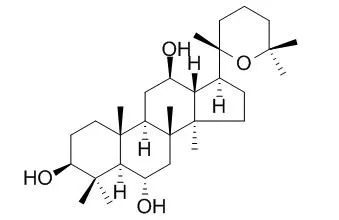| Description: |
Panaxatriol is an inducer of thioredoxin-1 (Trx-1), which exhibits anti-inflammatory, hepatoprotective, anti-arrhythmic, and antioxidative activities. It has pluripharmacological properties in the protection against Parkinson's disease (PD) including enhancing antioxidant activity, acting as neurotrophic factor, modulating inflammation and inhibiting mitochondria-mediated apoptosis. Panaxatriol has been shown to be efficacious in the prevention and treatment of cerebrovascular diseases in China, it may activate endogenous cytoprotective mechanism against OGD-Rep induced oxidative injury via the activation of PI3K/Akt and Nrf2 signaling pathway.
|
| In vivo: |
| Food Chem Toxicol. 2010 Jun;48(6):1516-20. | | The effects of ginseng total saponin, panaxadiol and panaxatriol on ischemia/reperfusion injury in isolated rat heart.[Pubmed: 20353807] | The aim of the present study was to evaluate the protective effect of ginseng total saponin, panaxadiol and Panaxatriol, which are the major components of Panax ginseng, against myocardial ischemia/reperfusion (I/R) injury in isolated rat hearts.
METHODS AND RESULTS:
Rats were orally administered once a day with total saponin (20 mg/kg), panaxadiol (5 mg/kg) and Panaxatriol (5 mg/kg) for consecutive 7 days. On day 8, the hearts were isolated and perfused with Krebs-Henseleit bicarbonate buffer solution using Langendorff apparatus. After 30 min of global ischemia, hearts were reperfused for 30 min. Myocardial function, coronary flow and biochemical parameters, such as lactate dehydrogenase (LDH), creatine kinase (CK), adenosine triphosphate (ATP), malondialdehyde (MDA) and reduced glutathione (GSH) were measured. Total saponin and Panaxatriol significantly improved I/R-induced myocardial dysfunction by increasing left ventricular development pressure, (-dP/dt)/(+dP/dt) and time to contracture. Moreover, the increases in the levels of LDH, CK and MDA and the decrease in the levels of GSH were attenuated by total saponin and Panaxatriol. However, the ATP levels did not affected by total saponin, panaxadiol and Panaxatriol pretreatment.
CONCLUSIONS:
Our findings suggest that pretreatment with ginseng total saponin, especially Panaxatriol, ameliorates I/R-induced myocardial damage and this protection is caused by reducing oxidative stress. | | J Ethnopharmacol. 2011 Jan 27;133(2):448-53. | | Protective effect of panaxatriol saponins extracted from Panax notoginseng against MPTP-induced neurotoxicity in vivo.[Pubmed: 20951784 ] | Panaxatriol saponins (PTS), the main constituents extracted from Panax notoginseng, a Chinese herbal medicine, has been shown to be an effective agent on various diseases. Our previous study has demonstrated that PTS is an inducer of thioredoxin-1 (Trx-1) and has a possible potential as a therapeutic agent for Parkinson's disease (PD). However, the effect of PTS on 1-methyl-4-phenyl-1,2,3,6-tetrahydropyridine (MPTP)-induced neurotoxicity in vivo is unknown.
METHODS AND RESULTS:
Using locomotor activity test and traction test, we detected the effect of PTS on MPTP-induced behavioral impairment. Tyrosine hydroxylase, Trx-1, cyclooxygenase-2, pro-caspase-9, pro-caspase-12 and caspase-3 expressions in the anatomical region of substantia nigra pars compacta (SNc) were tested by Western blot.
PTS provided neuroprotection against the loss of dopaminergic neurons and behavioral impairment caused by MPTP. MPTP-induced neuronal death in the SNc was suppressed by PTS through increasing Trx-1 expression, suppressing cyclooxygenase-2 over-expression and inhibiting mitochondria-mediated apoptosis.
CONCLUSIONS:
PTS, an inducer of Trx-1, has pluripharmacological properties in the protection against PD including enhancing antioxidant activity, acting as neurotrophic factor, modulating inflammation and inhibiting mitochondria-mediated apoptosis. |
|






 Cell. 2018 Jan 11;172(1-2):249-261.e12. doi: 10.1016/j.cell.2017.12.019.IF=36.216(2019)
Cell. 2018 Jan 11;172(1-2):249-261.e12. doi: 10.1016/j.cell.2017.12.019.IF=36.216(2019) Cell Metab. 2020 Mar 3;31(3):534-548.e5. doi: 10.1016/j.cmet.2020.01.002.IF=22.415(2019)
Cell Metab. 2020 Mar 3;31(3):534-548.e5. doi: 10.1016/j.cmet.2020.01.002.IF=22.415(2019) Mol Cell. 2017 Nov 16;68(4):673-685.e6. doi: 10.1016/j.molcel.2017.10.022.IF=14.548(2019)
Mol Cell. 2017 Nov 16;68(4):673-685.e6. doi: 10.1016/j.molcel.2017.10.022.IF=14.548(2019)